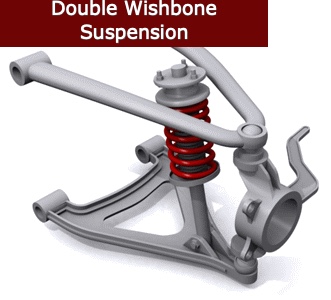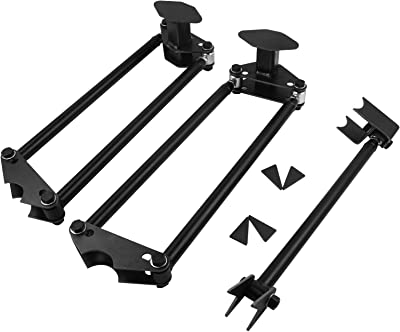Is a double wishbone better than a multi-link suspension? To be frank, it’s a tough debate, and the answer depends on what exactly you desire to get out of a suspension setup, your preferences, and your restrictions.
Typically, double wishbone suspensions are eminent for high-performance sports cars and sport utility vehicles. So, in that case, you might not think about any substitute choice. While multi-link suspensions are also a favorite among desert racers and off-road enthusiasts, the maintenance or repair cost can be a game changer here.
So, there could be a point where a double wishbone suspension beats multi-link suspensions, and you can say, “Yeah, it’s better here.” Here we’ll explore everything you need to know to justify whether a double wishbone is better for you than its multi-link counterpart.
Read also: 3 Link Suspension Vs 4 Link Suspension (Main Differences)
What is A Double Wishbone Suspension?

You could say such a system could also be used for an automobile’s elevated rack. Of course, a system with four arms in the front and two in the rear would be the most common. In reality, though, it truly is utilized by cars with two wishbone-shaped arms in the front and the rear.
From the design perspective, a double wishbone suspension is one kind of independent suspension. The axle between two wishbones implements lateral movement, while a knuckle on the axle attaches vertical cushioning and spring dampening.
Designed roughly 100 years ago for motor vehicles, the double wishbone suspension has been employed to provide a smooth traveling experience on difficult roads. Since it’s constructed based on a suspension design independent of each wheel, each wheel has a different suspension, and this single point can impact the level of harshness present on bumpy road surfaces.
Product Url: Double Wishbone Suspension
What is Multi-Link Suspension?

Suspensions with one or more longitudinal links are considered to be a type of multi-link suspension. A broader perception could encompass any independent suspensions with more than two links in differing lengths. The presence of these arms does not necessarily indicate an all-straight configuration; it may have angles differently from specific directions.
Loosely joined multi-links have a semispherical ball (hank) joint in a variable spot for complicated load distributions. Multiple-link bushes function in strain and fatigue because they are occasionally loaded unsymmetrically. Some are likewise fitted with an arm trailing arm, a control arm, or a crossbar, each of which has a joint at the end.
The front suspension receives the tie rod, which extends the rack or steering box to the wheel hub. Along with the solid axle multi-link system is another variation of the powertrain idea, offering advantages over independent multi-link, as it is considerably cheaper and easier to construct, offering outstanding mechanical resistance and believability.
Product Url: Multi-link Suspension
Is A Double Wishbone Better Than a Multi-Link Suspension?
The superiority of double wishbone suspensions will be prominent when you find a solid disadvantage of multi-link suspension where a double wishbone setup can be your solution.
Technically, many people think of a double wishbone suspension as a variation of multi-link suspension; however, a true multi-link suspension system is quite different in terms of design and mechanism.
Ease of Assembly and Tuning
Nobody wants complexity, and maybe you won’t. Multi-link suspensions have an extremely complex design, making assembly more difficult for the average driver. They are likewise tough to tune the geometry of without a full 3D computer-aided design analysis. A range of external forces will also need to be negated to decouple the system from all external forces.
Multibody simulation software can be used in order to verify that critical compliance has indeed been achieved. In the case of a double wishbone suspension, you’re free from that hassle.
Spacing and Alignment
A multi-link suspension system takes up an excessive amount of space due to the operation of several links. Also, it is quite difficult to align the wheels properly, and it can cause damage if you don’t know how to do it.
On the other hand, a double wishbone suspension is much easier to set up because fewer links are involved. However, even if you have a basic understanding, you still need to carry out the operation correctly as well.
Repair
Particularly with respect to dealing with problems, mechanics opine that multi-link setups are among the hardest to diagnose and fix. If you have a double wishbone setup on your car, at least you can rest assured that your mechanic will have no trouble fixing it.
Better Handling
Under the support of the vehicle, the presence of arm support increases the rigidity of double-wishbone suspensions. In this situation, park the car in more challenging places, such as hilly or warping ground, and you will grow more adept at dealing with it.
Cost
The strongest negative aspect is the intricacy of the multilink design, which results in many more points of failure and elevated repair costs. This is the fact we have mentioned in the beginning.
Yes, we will not deny that there are more adjustments and many places of damage on double wishbone suspension systems as well. That eventually makes them more costly than other suspension types, but they are simpler than multilink suspensions, and you have to spend less cash on it (at least less than a true multi-link suspension).
Disadvantages of A Double Wishbone Suspension System
To give you an impartial guide, we have also gathered some potential drawbacks of double wishbone suspension systems. Here we go:
Inefficient Torque Control
Manipulation signifies at least a part of the braking force is controlled by changing your whole body, and the traction force needs to be a section with the road not noticeable. To counteract this problem, the lower wishbone is usually extended to provide a better road.
After that, the issue of achieving a greater wishbone goes away, and you are left with a single wishbone; of course, the absorbing force of a longer wishbone results in more perpetrators.
Compatibility Issue
It is hard for a convertible-type double wishbone suspension to incorporate Land Rovers with front-wheel drive. Therefore, it is not suitable for all sorts of models and designs.
Related: Advantages And Disadvantages Of Double Wishbone Suspension